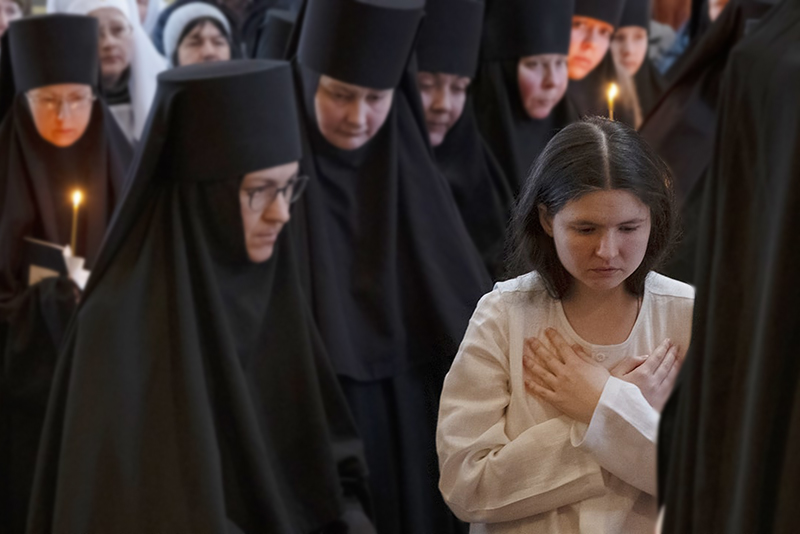
The basic principles of monastic life were formed in the early New Testament era, but monasticism as an institution did not appear until the 4th century. That time was characterized by the appearance of the first monasteries, the formalisation of ascetic ideals by mandatory rules and the introduction of the monastic vows taken during tonsure.
According to one of the existing versions, these vows originated in the monasteries of St Pachomius, the father of cenobitic monasticism. Many people joining his monasteries were not baptized until after years of testing their faith in the role of novices, they took monastic vows together with the sacrament of baptism.
Many years later, monastic vows were formalized and recorded in the orders of tonsure into the Lesser and Great Schema, both of which have remained virtually unchanged since that time.
The division between the Lesser and Great Schemas appeared after some hermit monks began to form cenobitic monasteries (the fourth century). It reflected the differentiation between the eremites, receiving the rank of “the great angelic image”, and the cenobitic monks, prefiguring the rank of the Lesser Schema.
In his rite of repentance (4th century) John IV of Constantinople mentions the monastic ranks of the Great and Lesser Schema. The fixed term for advancing from the cenobitic life to monastic solitude was 4 years.
In the late 8th – early 9th centuries, the three common degrees of monasticism included the novitiate, the Lesser and the Great Schema. St Theodore the Studite disapproves of this custom. He writes, “Do not differentiate between the so-called “little” and “great” schemas, for they, like baptism, represent one image, customary among the holy fathers”.
The Rassaphore Tonsure, introduced in the 10th century, does not include taking monastic vows. This order consists of three prayers and a dismissal, after which the newly tonsured monk is entrusted to his confessor.
The order of tonsure into the lesser schema is much longer and more solemn. During the chanting of the repentant troparion, the person being tonsured crawls from the narthex to the central part of the nave, where he is greeted by the abbot or bishop, announcing to him that God accepts one who is humbly repentant. Then, after making sure that the tonsured person chooses the “angelic image” voluntarily, the abbot or bishop accepts his monastic vows.
The first vow (stability of place) implies staying in a monastery. In addition to it, a monk promises to live in fasting, chastity, virginity, reverence, obedience and poverty. He also professes a willingness to observe monastic rules and endure the sorrows of monastic life.
The monastic vows are mentioned for the first time as a canonical act in Rule 19 of St Basil the Great, written in the second half of the 4th century. Answering the question of Amphilochius, Bishop of Iconium, the saint enjoins monastics to take a solemn vow of chastity, so that in case of violation, they could be punished, “…If they turn to a covetous and voluptuous life, may they be subject to penance and treated like those who commit adultery”. Later, the monastics violating their vow of chastity were left without communion for a year (the same penance was prescribed for bigamous marriages, according to Canon 19 of the Ancyra Local Council). After some more time, this term was extended to 15 years (penance for adulterers per Canon 44 of the Quinisext Council).
St Basil the Great issued many other rules regulating monastic life, which are still adhered to by the Orthodox Church. St Basil was the first to issue two editions of monastic rules, the more extensive Greater Monastic Rules (about the foundations of monastic life) and a shorter version regulating certain particularities.
According to the rules of St Basil the Great, the most important monastic vows are those of obedience and poverty.
Unconditional obedience to the elder has been mandatory for young monks since as early as the beginning of the 4th century, when, according to the statute of St Pachomius, literally nothing could be done without the elder’s permission. Such severity helped young monastics fight their pride, the most important of human sins. Later, St Basil the Great wrote in his Rules that monks must obey God, the abbot and one another. According to him, disobedience is one of the most severe and most dangerous sins, especially for a monk.
The importance of the vow of poverty was claimed by St Pachomius when he ordered his monks, admiring the beauty of a newly built chapel, to destroy it. The most authoritative ecclesiastical rule regarding monastic poverty is the 6th rule of the Council of Constantinople of 861, “Monks should not possess anything of their own, but everything that belongs to them should be approved by the monastery… After joining a monastic community, monastics delegate the power over all their property to the monasteries, losing their right to dispose of any of their belongings, or to bequeath them”.
Despite never being the subject of a single piece of legislation, monastic vows are regulated by general and specific rules. Being based on the Holy Scriptures, each vow originates with the very phenomenon of monasticism, continues to develop its shape in patristic literature and ultimately constitutes a key part of monastic life.




